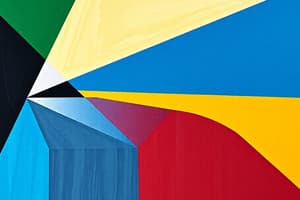Podcast
Questions and Answers
What does the word 'Geo' in geometry refer to?
What does the word 'Geo' in geometry refer to?
- Measurement
- Space
- Distance
- Earth (correct)
Which branch of geometry focuses specifically on the study of distances and spaces?
Which branch of geometry focuses specifically on the study of distances and spaces?
- Convex geometry
- Discrete geometry
- Euclidean geometry (correct)
- Differential geometry
Who is known as the earliest contributor to mathematics with a known name?
Who is known as the earliest contributor to mathematics with a known name?
- Wladimir Golenishchev
- Euclid
- Ahmes (correct)
- Thales of Miletus
What important mathematical document did Ahmes transcribe around 1550 BC?
What important mathematical document did Ahmes transcribe around 1550 BC?
What concept did Thales of Miletus introduce into geometry?
What concept did Thales of Miletus introduce into geometry?
What ancient cultures did Thales reportedly learn geometric techniques from?
What ancient cultures did Thales reportedly learn geometric techniques from?
Which of the following best defines Non-Euclidean geometry?
Which of the following best defines Non-Euclidean geometry?
Which purpose does Algebraic geometry primarily serve?
Which purpose does Algebraic geometry primarily serve?
What theorem helps find the missing side length of a right triangle?
What theorem helps find the missing side length of a right triangle?
Which of the following mathematicians is considered the 'father of geometry'?
Which of the following mathematicians is considered the 'father of geometry'?
What is true regarding the base angles of an isosceles triangle?
What is true regarding the base angles of an isosceles triangle?
Which of the following properties is NOT associated with the circle?
Which of the following properties is NOT associated with the circle?
Which ancient mathematician is credited with the discovery of the volume of a sphere?
Which ancient mathematician is credited with the discovery of the volume of a sphere?
In Euclidean geometry, what method does Euclid primarily use for his theorems?
In Euclidean geometry, what method does Euclid primarily use for his theorems?
What principle did Archimedes use to anticipate modern calculus?
What principle did Archimedes use to anticipate modern calculus?
Which assertion about straight lines intersecting is true?
Which assertion about straight lines intersecting is true?
What is the relationship between the cosecant and sine functions?
What is the relationship between the cosecant and sine functions?
Which pairs of trigonometric functions represent reciprocals of each other?
Which pairs of trigonometric functions represent reciprocals of each other?
What applications does core trigonometry cover?
What applications does core trigonometry cover?
Which period is known for the development of modern trigonometry?
Which period is known for the development of modern trigonometry?
Which ancient civilizations were known for their knowledge related to early trigonometry?
Which ancient civilizations were known for their knowledge related to early trigonometry?
What distinguishes spherical trigonometry from plane trigonometry?
What distinguishes spherical trigonometry from plane trigonometry?
Which function is defined as the quotient of sine over cosine?
Which function is defined as the quotient of sine over cosine?
How did ancient Babylonian astronomers utilize trigonometric concepts?
How did ancient Babylonian astronomers utilize trigonometric concepts?
What concept closely resembles the 'seked' mentioned in the Rhind Mathematical Papyrus?
What concept closely resembles the 'seked' mentioned in the Rhind Mathematical Papyrus?
What was Hipparchus primarily known for in relation to trigonometry?
What was Hipparchus primarily known for in relation to trigonometry?
What practical applications motivated Hipparchus's work in trigonometry?
What practical applications motivated Hipparchus's work in trigonometry?
In the Hellenistic period, how did Hipparchus view triangles in his work?
In the Hellenistic period, how did Hipparchus view triangles in his work?
What information did the Rhind Mathematical Papyrus provide regarding the building of pyramids?
What information did the Rhind Mathematical Papyrus provide regarding the building of pyramids?
What type of triangles did Hipparchus primarily study?
What type of triangles did Hipparchus primarily study?
What is a chord in the context of trigonometry as described by Hipparchus?
What is a chord in the context of trigonometry as described by Hipparchus?
What calculation does one need to perform to understand the length of a chord according to Hipparchus?
What calculation does one need to perform to understand the length of a chord according to Hipparchus?
What approximation of π is considered more accurate than Aryabhata's approximation?
What approximation of π is considered more accurate than Aryabhata's approximation?
Which concept did René Descartes contribute to modern mathematics?
Which concept did René Descartes contribute to modern mathematics?
What is one major aspect of projective geometry?
What is one major aspect of projective geometry?
Which of the following terms refers to a curve obtained from a cone's surface intersecting a plane?
Which of the following terms refers to a curve obtained from a cone's surface intersecting a plane?
What foundational principle does trigonometry explore?
What foundational principle does trigonometry explore?
What was the primary concern of trigonometry until the 16th century?
What was the primary concern of trigonometry until the 16th century?
Which unknown variables did Descartes use to represent equations?
Which unknown variables did Descartes use to represent equations?
Which of the following was NOT a field that utilized analytic geometry?
Which of the following was NOT a field that utilized analytic geometry?
Flashcards are hidden until you start studying
Study Notes
Geometry
- "Geo" translates to earth; "metre" means measurement; geometry deals with space properties including distance, shape, and size.
- Key branches of geometry include:
- Algebraic geometry
- Discrete geometry
- Differential geometry
- Euclidean geometry
- Non-Euclidean geometry
- Convex geometry
Egyptian Geometry
- Vladimir Golenishchev was a prominent Russian Egyptologist, known for contributions to the Cairo School of Egyptology.
- The Moscow Mathematical Papyrus is attributed to Golenishchev and includes significant mathematical problems.
- Ahmes, an Egyptian scribe, lived around the end of the Fifteenth Dynasty; he copied the Rhind Mathematical Papyrus (circa 1550 BC).
- The Rhind Mathematical Papyrus contains geometry problems and is a fundamental document in ancient Egyptian mathematics.
Greek Geometry
- Thales of Miletus (6th century BCE) pioneered deductive reasoning in geometry, introducing the proof concept.
- Notable axioms proposed by Thales include:
- A circle bisected by any diameter creates two equal halves.
- The base angles of an isosceles triangle are congruent.
- Angles opposite to crossed lines are equal.
- Pythagoras of Samos (570–495 BC) is known for the Pythagorean theorem, establishing the relationship (A^2 + B^2 = C^2) in right triangles.
- Euclid of Alexandria authored "Elements," laying the groundwork for geometric theorems based on axioms.
- Archimedes of Syracuse (287-212 BC) is renowned for advancing geometric principles, including the area and volume of shapes, utilizing concepts of infinitesimals.
French Geometry
- René Descartes (1596-1650) connected geometry and algebra, creating analytic geometry and standard notations for variables.
- Blaise Pascal (1623-1662) contributed to projective geometry, focusing on properties invariant under projective transformations.
- Conic sections, categorized as hyperbola, parabola, and ellipse, arise from intersecting a cone with a plane, with circles being a special ellipse case.
Trigonometry
- Trigonometry examines sides and angles of triangles; "trigonon" means triangle and "metron" means to measure.
- Early applications of trigonometry involved calculating missing triangle parts based on known values.
- The six trigonometric functions are:
- Sine (sin)
- Cosine (cos)
- Tangent (tan)
- Cotangent (cot)
- Secant (sec)
- Cosecant (csc)
- Relationships among functions include:
- (csc A = \frac{1}{sin A})
- (sec A = \frac{1}{cos A})
- (cot A = \frac{1}{tan A})
Types and Applications of Trigonometry
- Plane trigonometry deals with angles and distances in two dimensions.
- Spherical trigonometry applies to problems in three-dimensional space.
- Trigonometry is vital in fields like astronomy, navigation, and physical sciences, providing tools for distance and height measurements.
History of Trigonometry
- Classical trigonometry originated in ancient civilizations, notably Egypt and Babylon, which had practical geometry knowledge.
- Babylonian astronomers recorded celestial movements, indicating familiarity with angular measurements.
- The Rhind Mathematical Papyrus reflects early trigonometric concepts related to the "seked," akin to cotangent.
- Hipparchus (c. 190-120 BC), depicted as the "father of trigonometry," created the first trigonometric tables relating angles to chord lengths for astronomy.
- Hipparchus utilized trigonometry to enhance celestial measurements, bridging the gap between mathematical theory and practical application in astronomy.
Studying That Suits You
Use AI to generate personalized quizzes and flashcards to suit your learning preferences.




